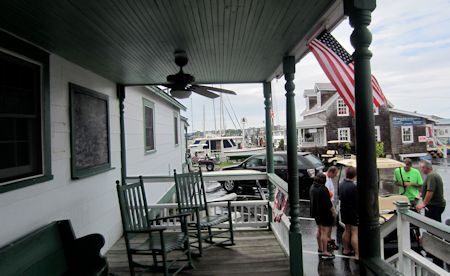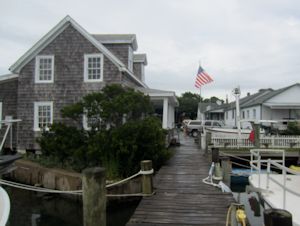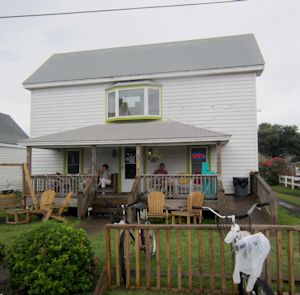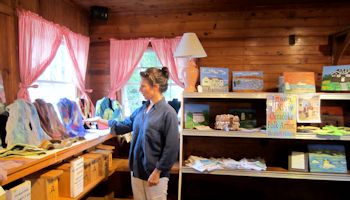 The porch of the Community Store overlooks the square that is the heart of old Ocracoke. Photo: Catherine Kozak |
OCRACOKE — For a tourist town, bathrooms are a big deal. For a tourist town surrounded by water, public access to the water is a necessity. For a tourist town dependent on the cleanliness of that water, stormwater runoff from the street should not be flowing into that water.
Somehow, what seems like obvious planning details have not been tended to in Ocracoke Village, a remote Outer Banks community bursting at the seams every summer with thousands of visitors, who snake through traffic on skinny streets in vehicles, on foot or on their rented bicycles and golf carts.
Supporter Spotlight
When it rains, the water from the heavily trafficked main road is fed into Silver Lake harbor — right off the Community Square in the heart of the tiny village that is home to 900 year-round residents. Off the docks at the square is some of the village’s only public access to the harbor. The only public restrooms, besides a few porta-potties, are on the outskirts of the village at the National Park Service Visitors Center.
Under the umbrella of the Ocracoke Foundation, the Community Square Revitalization Project proposes to not only preserve the square and its docks for public use with protective easements, it also is aims to manage the stormwater, restore the shoreline, provide wastewater treatment so restrooms can be built and protect clean water with a dedicated boat pump out.
“We want people to be able to come to the harbor and sit down and enjoy it and not have to buy a beer or a burger,” said Robin Payne, executive director of the foundation, a nonprofit established in 2006 to help preserve Ocracoke. “Pedestrian access is as important as boat access. The harbor is the focal point of the tourist experience. That’s what draws people in — it’s the historic village that surrounds the harbor.”
 The Community Square dock provides public access to Silver Lake, |
 The Ocracoke Foundation hopes to also buy the Dixon-Williams House across from the Community Square. Photos: Catherine Kozak |
The $2.2 million project would cover purchase of the square and the 1913 Dixon-Williams house and 16,900 square feet of land across the street from the square, both being sold at appraised value, Payne said. Engineers will design wastewater treatment improvements on the Dixon-Williams property that will make it possible to build public bathrooms and a community kitchen to process specialty products from Ocracoke Seafood Co. to sell online.
Based on the project’s goal to preserve and create jobs and to protect the environment, public waterfront access and the island’s cultural heritage, the foundation is currently seeking money from state, federal and private foundations to finance the project by March 2013.
Supporter Spotlight
Existing business leases would be maintained, Payne said, and a portion of the money would provide a steady revenue stream that would be put back into the village. A manager would be hired to oversee day-to-day operations at the Square.
“If Ocracoke and its residents are going to take hold of change and think about its future,” she said, “it really needs access to dedicated funding and responsible asset development . . . because I don’t think it’s reasonable to plan for the future with grants and donations.”
Payne said that the project would restore the square to its original simplicity. Asphalt walkways would be replaced with concrete instead of modern pavers. A rain garden with resilient native plants would be planted in the middle of the square to help drain stormwater. The docks would be repaired.
When the project is completed, she envisions that the square will again be the vibrant center of the community, where folks can come together for events and open-air markets can thrive.
Numerous events held in the square this year, including the Ocrafolk Festival Dance and Women’s Arm Wrestling at the beginning of the summer, illustrate the square’s value as a gathering place, Payne said. The Homemade Homegrown market, selling products produced or created by local residents, expanded so much and became so popular, it was moved inside the Community Store at the square to be opened for business every Wednesday.
Historically, much of the village activity centered on the Community Store, which since it was first built in 1918 has provided everything from candy to coffins for villagers. Until recently, it had also been a popular stop for vacationers.
The store, with rocking chairs on a shaded wooden porch, draws tired, hot tourists like flies to honey — even though it is not currently open.
Diane Peeler, visiting from Norfolk with her husband, stopped by last week to buy drinks and take a break from walking. Wearing a big sun hat and sensible shoes, she sat down with a sigh and started rocking. Her husband went to the door, saw the sign on the door and announced it was closed.
“Well that doesn’t make sense,” she responded. “Does it say for today, tomorrow or for always?”
It’s a question that has troubled villagers about the historic store for more than six years, when the Community Square was put on the market for $3.5 million. Over that time, the business has been closed months at a time in shifts of ownership.
Tenants have also come and gone at the other buildings in the square, now occupied by a kite store, an ice cream shop, a watermen’s exhibit, a nautical store and a boat tour business.
 Robin Payne shows off items in the Community Store that were made by Ocracoke residents. Photo: Catherine Kozak |
“All of this is doing exactly what I wanted to do,” said David Senseney, who bought the store in 1980 and the rest of the square four years later. “I am so glad that this will become community owned.”And if not for the stubbornness of the property’s owner to wait for the right buyer, and the determination of the foundation, working with the nonprofit Trust for Public Land, to be that buyer, it could be lost to development in a village with minimal zoning restrictions.
Senseney, one of the founders of the Ocracoke Preservation Society, wanted to sell the property, — which includes two docks with 15 boat slips, a large parking lot and four historic buildings — to help fund his retirement, but at the same time, he wanted the new owner to agree to preservation easements.
A former teacher of biology and entrepreneurship for 22 years at the Ocracoke School, Senseney said he turned down a “substantial” offer from a prospective buyer who wanted to turn the waterfront into an exclusive private yacht club. Even though the market now has dropped considerably, he said he is willing to take the financial hit.
“I’m 67-years-old. It’s time to do it, “ said Senseney who now lives fulltime near Asheville. “I’m ready to be done with it. But I wouldn’t be ready to be done with it if it weren’t being taken care of.”
James Paul, who ran the 3,000 square-foot store with his wife for four years until Hurricane Irene in August 2011 put them out of business, came by and explained to the Peelers and several other people who walked up to the porch that the store was closed indefinitely, but there’s hope that someone else will be able to reopen it next spring.
“A lot of people ask, because people are just used to coming here,” said Paul, a 43-year-old native islander who speaks with the distinctive Ocracoke brogue.
Paul, who today operates a go-cart rental business, said he supports what the foundation is trying to do. Over his lifetime, he’s seen lots along the “creek” — the term locals use for Silver Lake, once called Cockle Creek — be developed, and the subsequent loss of access. He has seen how haphazard change has threatened the heritage and image of the fishing village he knows so well.
“I think this is a good thing,” he said, looking from the store’s porch at the bustling square. “This is old Ocracoke right here.”







